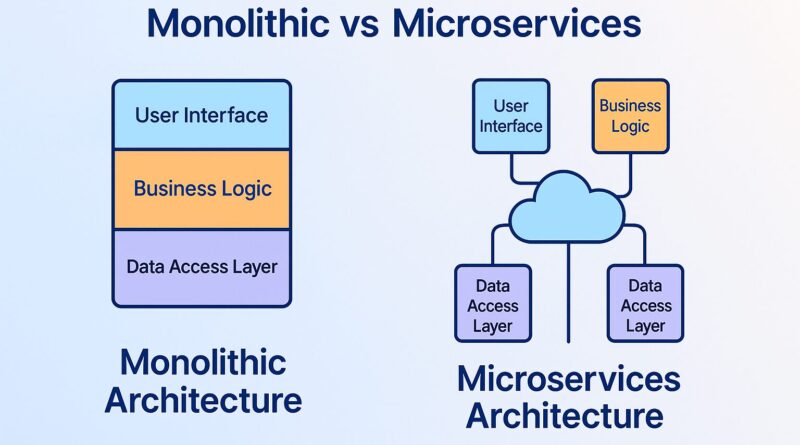Monolithic vs Microservices in 2025: Which Architecture Wins?
Monolithic vs microservices is a hot topic in software architecture — and in 2025, the decision between the two has never been more impactful. Whether you’re building a startup MVP or scaling an enterprise system, choosing the right architecture shapes your development, scalability, and even your team’s productivity.
In this post, we’ll explore what both architectures are, their pros and cons, and when to choose one over the other. We’ll also highlight real-world use cases, migration strategies, and best practices for both models.
What is a Monolithic Architecture?
A monolithic architecture is a single, unified codebase where all components of the application — UI, business logic, database operations — reside in one structure. This model is simple, often faster to build, and easy to test.
Benefits of Monolithic Architecture:
- Simplicity: Easier to develop and deploy for small teams.
- Performance: Lower latency due to in-process calls.
- Easier Debugging: One app = one log system.
Drawbacks of Monolithic Architecture:
- Scalability Limits: Difficult to scale individual components.
- Tight Coupling: A change in one area can break others.
- Slower Releases: Deployment involves the entire application.
Use Case: Startups, MVPs, internal tools.
What is Microservices Architecture?
Microservices architecture breaks the application into independent services. Each service is deployed, scaled, and maintained separately — typically with its own database and APIs.
Benefits of Microservices:
- Scalability: Scale services independently based on demand.
- Flexibility: Teams can use different languages or frameworks.
- Faster Deployment: Services can be deployed without affecting the whole app.
Drawbacks of Microservices:
- Complexity: Requires service discovery, communication protocols, and DevOps automation.
- Debugging Difficulties: Distributed systems mean distributed logs.
- Latency: Network calls between services can slow down performance.
Use Case: Large-scale apps, real-time platforms, SaaS products.
Monolithic vs Microservices: Side-by-Side Comparison
| Feature | Monolithic | Microservices |
|---|---|---|
| Codebase | Single unified codebase | Multiple independent services |
| Deployment | Deploy as one unit | Deploy services separately |
| Scalability | Horizontal scaling is difficult | Easily scalable per service |
| Technology Stack | Usually one tech stack | Polyglot possible |
| Communication | In-process calls | Over the network (REST, gRPC, etc.) |
| Testing | Easier to test end-to-end | Requires integration and contract testing |
| DevOps Complexity | Minimal | Requires advanced orchestration (K8s, Docker) |
| Time-to-Market | Faster for simple apps | Better for long-term iteration |
When to Choose Monolithic Architecture in 2025
Not every app needs microservices. In fact, starting with a monolith can often be the smartest choice for:
- Startups building MVPs
- Internal tools with limited user base
- Small teams with fewer resources
- Projects with short deadlines
💡 Tip: Many successful companies started with monoliths — including Twitter, Shopify, and Airbnb — and scaled later.
When Microservices Make Sense in 2025
Choose microservices if your application:
- Handles millions of users and requires horizontal scaling
- Has domain-driven complexity (e.g., payment, auth, analytics)
- Needs independent team ownership and continuous deployment
- Requires resilience (fault isolation between services)
🛠️ Example: Netflix adopted microservices to manage global scalability and uptime, with hundreds of services running independently.
Migrating From Monolith to Microservices
Many teams begin with a monolith and gradually evolve into microservices using a modular decomposition strategy. Here’s how:
Step-by-Step Migration Plan:
- Identify bounded contexts (e.g., user management, orders).
- Extract services one at a time using APIs or message brokers (Kafka).
- Refactor the database — move from shared schema to separate databases.
- Implement observability — use centralized logging and monitoring.
- Automate deployments with CI/CD pipelines.
Common Pitfalls:
- Over-engineering from the start.
- Lack of clear service boundaries.
- Not accounting for network latency and security.
Real-World Examples
- Amazon: Started as a monolith, now runs thousands of microservices.
- Uber: Struggled with microservices sprawl, then adopted domain-driven design.
- Shopify: Embraced modular monoliths before gradually moving to service-based architecture.
Tools That Help Both Worlds
For Monoliths:
- Ruby on Rails, Laravel, Spring Boot: Full-stack frameworks.
- Heroku, Vercel: Great for simple deployments.
For Microservices:
- Docker & Kubernetes: Container orchestration.
- API Gateway (e.g., Kong, NGINX): Handles routing, security.
- Kafka/RabbitMQ: Messaging between services.
- Prometheus + Grafana: Monitoring and observability.
Final Verdict: Which One to Choose?
There’s no one-size-fits-all answer. Your choice between monolithic vs microservices depends on:
- Project scope and complexity
- Team size and skillset
- Scalability and future-proofing needs
- Time-to-market pressure
🔍 Pro tip: If in doubt, start with a monolith and modularize it. Microservices are expensive — only migrate when there’s a compelling reason.
Helpful Resources
- 🔗 Martin Fowler on Microservices
- 🔗 12-Factor App — Best practices for building modern apps
- 🔗 Microservices.io — Patterns and principles
Want to Dive into Other Trending Tech Topics in 2025?
Explore more of our expert-written guides and insights
- 🔗 Top 5 Terraform Alternatives You Should Know in 2025 (With Pros & Use-Cases)
- 🔗 Kubernetes vs Amazon ECS (Fargate/EC2): Best in 2025?
- 🔗 Kubernetes vs Docker Swarm in 2025: Which One Should You Choose?
- 🔗 Top 10 Must-Have Gadgets Powered by NVIDIA Tech in 2025
- 🔗 GitHub Actions vs. Jenkins for Beginners: What to Use in 2025?
- 🔗 Simplified Microservices Deployment on AWS ECS


Pingback: How To Create A Smart Contract On Ethereum: Step-by-Step Guide (2025)
Pingback: Top 10 NFT Artists Of 2025: Ranking The Market Leaders
Pingback: Top 10 Blockchain Mining Software In 2025 (Reviewed)
Pingback: Top 10 Blockchain Testnets For Developers In 2025
Pingback: The Future Of Real Estate With NFTs: Opportunities And Risks
Pingback: Key Differences Between ERC-721 And ERC-1155 NFTs: A Comprehensive Comparison
Pingback: Top 10 Best Budget Monitors For Coding Under ₹5,000 In 2025